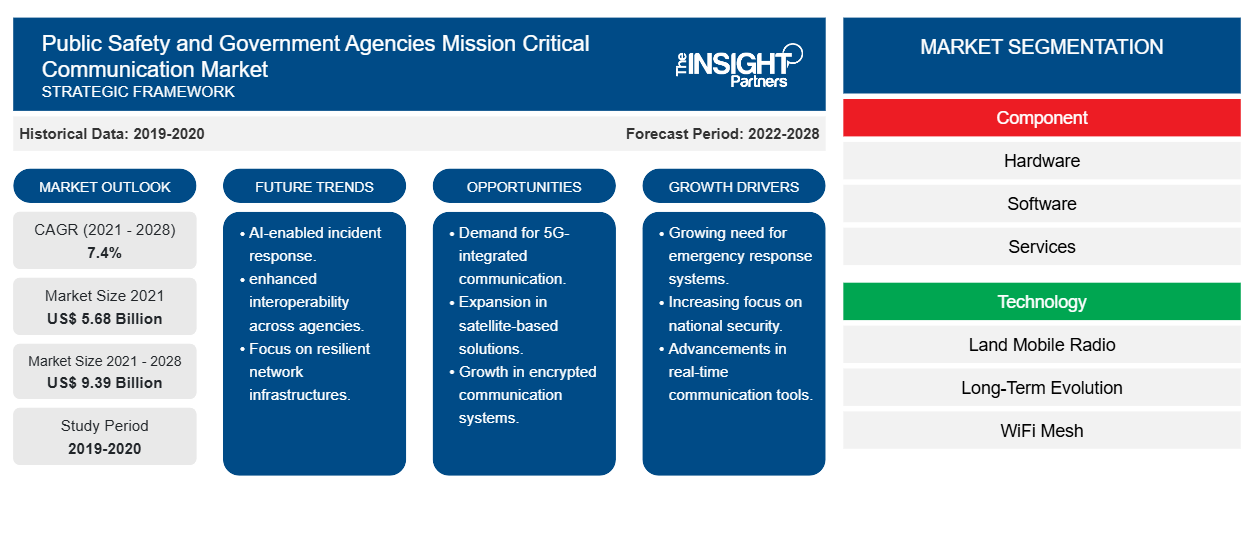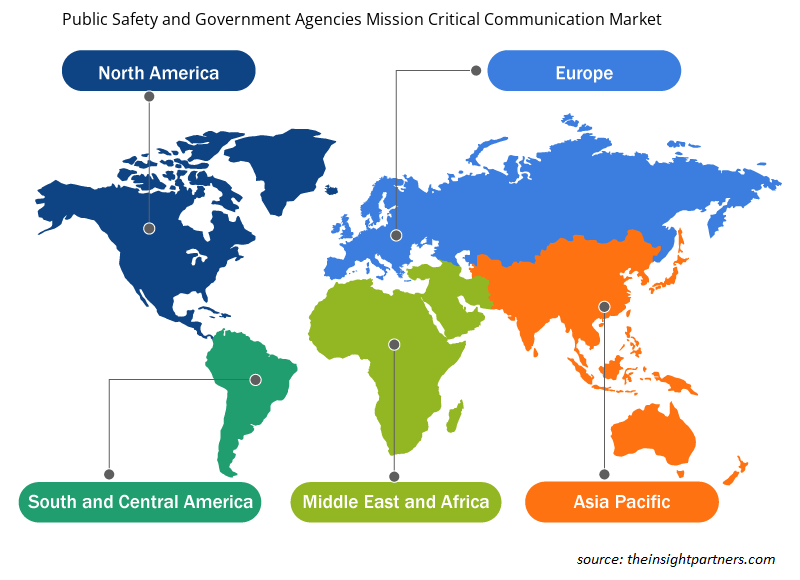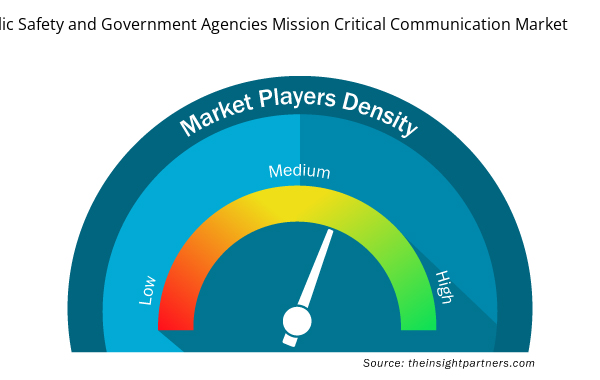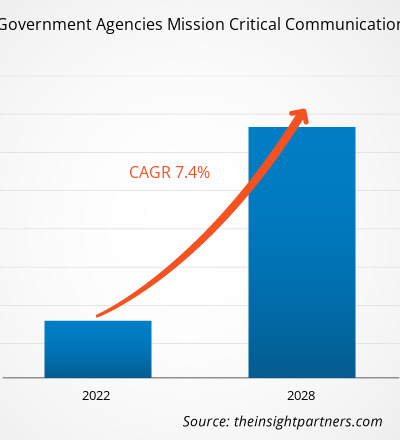The public safety and government agencies mission critical communication market was valued at US$ 5,684.3 million in 2021 and is projected to reach US$ 9,390.0 million by 2028; it is expected to grow at a CAGR of 7.4% from 2021 to 2028.
A mission-critical communication involves solutions that aid communication methods to end users in situations where traditional systems fail to meet their demands. Also, the public safety and government agencies mission critical communication market facilitates communication and supports operations that are fraught with danger to people and property. Crucial communication devices are used to educate people about the critical situations. In public safety and government agencies mission critical communication market, the network operators focus on new design and management strategies for communications infrastructure to respond to the rapid network and service evolution to assure reliable network operation.
Impact of COVID-19 Pandemic on Public Safety and Government Agencies Mission Critical Communication Market
The COVID-19 epidemic significantly affected the public safety and government agencies mission critical communication market in North America, resulting in substantial financial losses for end-use industries, pushing them to postpone their MCX implementation plans even more. The epidemic also impacted operations at public safety and government agencies mission critical communication market hardware manufacturing sites, requiring a brief halt. As a result, several significant component suppliers and technology providers cut costs and output. As the demand for electronics remained constant, it helped the market to resume growth.
Customize This Report To Suit Your Requirement
You will get customization on any report - free of charge - including parts of this report, or country-level analysis, Excel Data pack, as well as avail great offers and discounts for start-ups & universities
Public Safety and Government Agencies Mission Critical Communication Market: Strategic Insights

- Get Top Key Market Trends of this report.This FREE sample will include data analysis, ranging from market trends to estimates and forecasts.
You will get customization on any report - free of charge - including parts of this report, or country-level analysis, Excel Data pack, as well as avail great offers and discounts for start-ups & universities
Public Safety and Government Agencies Mission Critical Communication Market: Strategic Insights

- Get Top Key Market Trends of this report.This FREE sample will include data analysis, ranging from market trends to estimates and forecasts.
Market Insights
Rising Demand from Various Government Agencies Propelling the Growth of Public Safety and Government Agencies Mission Critical Communication Market
Citizens expect 24 hours per day service and communication from government agencies. They desire easy access to correct, up-to-date information and a smooth connection with the appropriate government officials. They also want services to be delivered swiftly, effectively, and transparently and problems to be resolved quickly, effectively, and openly. Many government agencies still rely on outdated communications infrastructures, such as leased PBX systems or Centrex-type systems. Also, in public safety and government agencies mission critical communication market, Governments are developing and maintaining excellent communication systems to be respectable players in public spheres. The above factors enable them to assess residents' needs and preferences and promote a deliberative public arena for multi-stakeholder involvement, informed policy debate, and emergency development efficacy. All of these issues propel the demand for public safety and government agencies mission critical communication market.
Component-Based Market Insights
The hardware components of public safety and government agencies mission critical communication market include command and control centers, router and gateways, and distribution management systems. The deployment of hardware components varies with the nature of public safety agency. The growing number of crimes being reported worldwide propels the demand for public safety and government agencies mission critical communication market.
Technology-Based Market Insights
Land mobile radio (LMR), also known as two-way radio, is one of the most widely used communication technologies in public safety and government agencies mission critical communication market. The technology is continuously under test and refinement and is considered as benchmark of success for critical communications, especially in public safety.
In public safety and government agencies mission critical communication market, product development is the commonly adopted strategy by companies to expand their product portfolio, which helps them enlarge their customer base and maintain their brand name. A few of the recent key developments in the market are as follows:
- In 2021, the government of the Republic of Indonesia deployed 500 Iridium Push-to-Talk (PTT) devices, procured from Iridium Communications Inc., to boost communication operations across the country. The Indonesian government now has a reliable "grab-and-go" real-time satellite communications solution, appropriate for on-the-go communications across the country's numerous island landscapes.
- In 2021, Inmarsat confirmed that BSNL, its strategic partner in India, has secured the requisite licenses to deliver Inmarsat's world-class Global Xpress (GX) mobile broadband services. GX will be provided to Indian customers across government, aviation, and marine sectors, under BSNL's Inflight and Maritime Connectivity (IFMC) license from the Department of Telecommunications.
Public Safety and Government Agencies Mission Critical Communication Market Regional Insights
The regional trends and factors influencing the Public Safety and Government Agencies Mission Critical Communication Market throughout the forecast period have been thoroughly explained by the analysts at Insight Partners. This section also discusses Public Safety and Government Agencies Mission Critical Communication Market segments and geography across North America, Europe, Asia Pacific, Middle East and Africa, and South and Central America.

- Get the Regional Specific Data for Public Safety and Government Agencies Mission Critical Communication Market
Public Safety and Government Agencies Mission Critical Communication Market Report Scope
| Report Attribute | Details |
|---|---|
| Market size in 2021 | US$ 5.68 Billion |
| Market Size by 2028 | US$ 9.39 Billion |
| Global CAGR (2021 - 2028) | 7.4% |
| Historical Data | 2019-2020 |
| Forecast period | 2022-2028 |
| Segments Covered |
By Component
|
| Regions and Countries Covered | North America
|
| Market leaders and key company profiles |
Public Safety and Government Agencies Mission Critical Communication Market Players Density: Understanding Its Impact on Business Dynamics
The Public Safety and Government Agencies Mission Critical Communication Market is growing rapidly, driven by increasing end-user demand due to factors such as evolving consumer preferences, technological advancements, and greater awareness of the product's benefits. As demand rises, businesses are expanding their offerings, innovating to meet consumer needs, and capitalizing on emerging trends, which further fuels market growth.
Market players density refers to the distribution of firms or companies operating within a particular market or industry. It indicates how many competitors (market players) are present in a given market space relative to its size or total market value.
Major Companies operating in the Public Safety and Government Agencies Mission Critical Communication Market are:
- Ascom Holding AG (Ascom)
- Globalstar
- Inmarsat Global Limited
- Iridium Communications Inc.
- nbn co ltd.
Disclaimer: The companies listed above are not ranked in any particular order.

- Get the Public Safety and Government Agencies Mission Critical Communication Market top key players overview
Public Safety and Government Agencies Mission Critical Communication Market Segmentation:
By Component
- Hardware
- Software
By Technology
- Long-Term Evolution (LTE)
- Land Mobile Radio (LMR)
- WiFi Mesh
Company Profiles
- Ascom Holding AG (Ascom)
- Globalstar
- Inmarsat Global Limited
- Iridium Communications Inc.
- nbn co ltd.
- SES S.A.
- Telesat
- Thuraya Telecommunications Company
- AT&T Inc.
- SPACEX
- Historical Analysis (2 Years), Base Year, Forecast (7 Years) with CAGR
- PEST and SWOT Analysis
- Market Size Value / Volume - Global, Regional, Country
- Industry and Competitive Landscape
- Excel Dataset



Report Coverage
Revenue forecast, Company Analysis, Industry landscape, Growth factors, and Trends

Segment Covered
Component, Technology

Regional Scope
North America, Europe, Asia Pacific, Middle East & Africa, South & Central America

Country Scope
Argentina, Australia, Brazil, Canada, China, France, Germany, India, Italy, Japan, Mexico, Russian Federation, Saudi Arabia, South Africa, South Korea, United Arab Emirates, United Kingdom, United States
Frequently Asked Questions
Which region dominated the Public Safety And Government Agencies Mission Critical Communication (MCX) Market in the forecast period?
North America is known for placing a high value on public safety, with regional and national governments devoting large resources to the cause. For example, in 2020, the New York Police Department had a budget of $5.92 billion, the Los Angeles Police Department had a budget of $1.86 billion, the Chicago Police Department had a budget of $1.76 billion, the Philadelphia Police Department had a budget of $4.9 billion, and the Toronto Police Department had a budget of $1.22 billion.
Which technology dominated the Public Safety And Government Agencies Mission Critical Communication (MCX) Market in the forecast period?
In terms of market share, the market was dominated by the Long-Term Evolution (LTE) segment, which accounted for 49.7% of the total market share in 2020 and is expected to reach 47.8% of the market share by 2028. Long term evolution (LTE), commonly known as 4G (Fourth Generation) wireless standard, offers increased network capacity and speed for cellular communication devices. LTE offers up to 100 Mbps of download and 30 Mbps upload speed. One of the biggest advantages of using LTE in mission critical communication is data connectivity. Prior to LTE, the mission critical communication was majorly voice based with limited data usage. The introduction of LTE bought a wide range of applications, such as broadcasting or multi-casting, live streaming, and device-to-device communications in mission critical communication. LTE is capable of unify the existing mission critical networks based on disparate technologies, such as terrestrial trunked radio (TETRA), ultra high frequency (UHF), and very high frequency (VHF). Moreover, with the increasing use of connected devices such as drones and cameras by public safety agencies, the adoption of LTE for mission critical communication is expected to witness a significant growth during the forecast period.
Who is the key player in the Public Safety And Government Agencies Mission Critical Communication (MCX) Market?
A few key players operating in the public safety and government agencies mission critical communication (MCX) market are Ascom Holding AG (Ascom), Globalstar, Inmarsat Global Limited, Iridium Communications Inc., nbn co ltd., SES S.A., Telesat, Thuraya Telecommunications Company, AT&T Inc., and SPACEX, which are profiled in the report.
Which component segment is expected to dominate the market in the forecast period?
The global Public Safety and Government agencies mission critical communication (MCX) market was dominated by the hardware segment in 2020, which accounted for 49.1% of market share. The hardware segment is anticipated to continue its dominance during the forecast period as well. The mission critical communication is one of the prominent systems offering public safety agencies a dedicated communication platform. The hardware component of mission critical communication consists of command and control center, router and gateways, and distribution management system. The deployment of hardware component various and differs according to the nature of public safety agency. The growing number of criminal reporting across the world propels the demand for mission critical communications by public safety agencies worldwide, which drives the market growth for the hardware segment.
What are market opportunities for Public Safety And Government Agencies Mission Critical Communication (MCX) Market?
Many lives are lost as a result of natural calamities. Some losses could have been avoided if public agencies had offered timely information about the nature of the crisis and how to respond. For example, many lives could have been saved in Thailand in 2004 if PSAs had warned the people of the impending tidal wave. In addition, public warnings can be helpful in situations like terrorist attacks and other catastrophic events, such as the Fukushima Daichi nuclear power plant accident and the Tianjin port explosion. For this reason, public warnings share many characteristics of mission-critical communications. When properly hardened, commercial 3G and 4G networks can provide PSAs with performance and dependability superior to private radio networks. Government agencies can develop additional sites for increased redundancy, capacity, and coverage to raise backhaul bandwidth and improve physical security. The mobile network's resiliency and robustness will be increased due to this 'hardening,' such that in the case of a power outage or network infrastructure damage, the network can remain operational for a prolonged length of time. It is vital to guarantee that the standards for products and services that supply mission-critical communications are of the highest possible quality because there are scenarios where a service failure could have disastrous implications. Therefore, sufficient efforts are made to build resilient products. Mission-critical communications are not limited to a relatively small market, such as public safety, but rather that economies of scale are fully leveraged so that the additional development costs required to ensure the desired quality are shared across a more extensive user base.
What are reasons behind Public Safety And Government Agencies Mission Critical Communication (MCX) Market growth?
The Public Safety and Government agencies mission critical communication (MCX) market is growing because of the global rise in terrorism, public safety, and desire for a reliable network during emergencies. However, the market's growth is hampered by high implementation costs, restricted data transit capabilities, and limited spectrum bandwidth. Government investments in mission-critical communication systems in the defense sector, on the other hand, are likely to generate attractive prospects for the industry in the coming years.
Trends and growth analysis reports related to Electronics and Semiconductor : READ MORE..
The List of Companies - Public Safety and Government Agencies Mission Critical Communication Market
- Ascom Holding AG (Ascom)
- Globalstar
- Inmarsat Global Limited
- Iridium Communications Inc.
- nbn co ltd.
- SES S.A.
- Telesat
- Thuraya Telecommunications Company
- AT&T Inc.
- SPACEX

 Get Free Sample For
Get Free Sample For